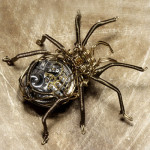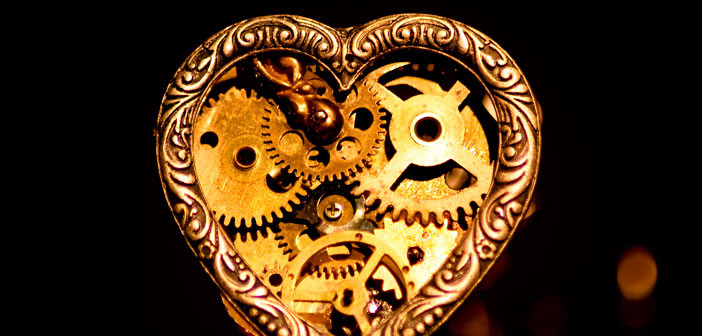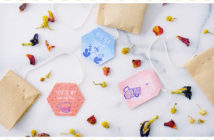 Matching tea sets and silver are so yesterday. Combined with the frou-frou pink and pastel decorations as well as precious little tea cakes, the typical Victorian tea party can be stuffy and boring. For your next party, bring the past up to a new standard by introducing the unexpected—a little bit of a gothic kick with food and favors to match. Go ahead, get a little steampunk tea party going. Starting with the decorations.
Matching tea sets and silver are so yesterday. Combined with the frou-frou pink and pastel decorations as well as precious little tea cakes, the typical Victorian tea party can be stuffy and boring. For your next party, bring the past up to a new standard by introducing the unexpected—a little bit of a gothic kick with food and favors to match. Go ahead, get a little steampunk tea party going. Starting with the decorations.
Industrial Chic
To really transform the stuffy Victorian tea party, steampunk it out! The style mixes vintage, historical elements with a shot of industrialized futurism for an otherworldly look sure to delight your guests. Have a centerpiece made of oversized gears. Go a little Mad Hatter and use pocket watches as place card holders. Keep your color scheme mechanized with silvers, grays, dark browns, and blacks. Skulls, globes, padlocks, and candles can complement your table decorations.
Forget that standard tablecloth. Go with a lace or thin webbing. Above all—no matchy-matchy china or tableware. Stay with lightly deco rated cups and saucers and make sure they don’t coordinate. Your main goal is industrial eclectic with only hints of the past. To really drive it home, lose the table and chairs altogether and have your party picnic style. Encourage your guests to come in costume: elaborate dresses for the ladies and top hats for the men, but with unique modern touches thrown in—like oversized goggles, chains, or platform shoes.
rated cups and saucers and make sure they don’t coordinate. Your main goal is industrial eclectic with only hints of the past. To really drive it home, lose the table and chairs altogether and have your party picnic style. Encourage your guests to come in costume: elaborate dresses for the ladies and top hats for the men, but with unique modern touches thrown in—like oversized goggles, chains, or platform shoes.
Feed the Hunger
Carry the steampunk theme through your food. Instead of sandwiches, have pasties, a dough pocket filled with meat, vegetables, and potatoes that miners typically ate for lunch down in the coal, copper, and iron mines in the 1800s.
Keep the standard teacakes and cookies, but forget the pretty pink icing and instead choose to go with dark gray or black. Crown each with a little sugar top hat. If you want to get more creative, cut the cookies into gear shapes. Make all your food choices dark—think rum balls, dark bread, meatballs with deep red sauce, and hearty soups.
Teas’ Hidden Meanings
Brewing tea from fresh-grown plants may be an ancient practice, but put a modern spin on your tea table with placards stating the historical meaning and use of each plant. Start with these five examples then research and repeat for every additional tea you offer.
Lavender
Meaning: Derived from lavare, meaning “to wash,” due to its use in scenting ancient bathwater.
Uses: Relieves headaches and burns, calms nerves, aids restful sleep.
Symbolizes: Devotion and love
Chamomile
Meaning: Derived from khamaimēlon, meaning “ground apple,” due to a scent similar to apple blossoms.
Uses: Relaxes muscles, settles stomach, improves oral hygiene.
Symbolizes: Decisiveness
Echinacea
Meaning: Derived from echinos, meaning “hedgehog,” or “sea urchin” due to its prickly appearance.
Uses: Boosts immune system, quickens healing, reduces swelling.
Symbolizes: Good health
Peppermint
Meaning: Derived from mentha and piperita, meaning “mint” and “pepper,” due to its peppery variety of mint.
Uses: Eases digestion issues, eliminates headaches, lowers fevers.
Symbolizes: Politeness
Dandelion
Meaning: Derived from dent de lion, meaning “lion’s tooth,” due to its spiky petal appearance.
Uses: Diuretic, improves liver health, vitamin supplement.
Symbolizes: Faithfulness and happiness
DIY Tea Tastes
Forget those stale and typical tea blends. Put these recipes on cards next to your fresh tea plants and let your guests blend to their own taste.
The Lovers’ Blend: Two parts lavender to one part peppermint and one part dandelion. This blend takes the best parts of the relationship plants and mixes them together: lavender’s devotion and love, peppermint’s politeness, and dandelion’s faith and happiness.
The Booster Shot: Two parts Echinacea and two parts dandelion to one part peppermint. Settle your stomach with peppermint, get your vitamins with dandelion, and enjoy Echinacea’s overall immune boost.
The Tummy Tamer: Two parts peppermint to one part chamomile and one part lavender. Have an upset stomach? Fight the quease with the stomach settling powers of these three plants.
The CEO: One part chamomile to one part peppermint. Decisiveness and politeness will take you far in the business world—let your personal tea blend give you an edge on the competition.
Fauna Focused Blend: One part Echinacea to one part dandelion. Pay homage to earth’s creatures with this blend that celebrates the lion and the hedgehog.
The Cure-All Tonic: Combine all in equal parts. Get all the benefits of every plant in one cup with this blend.
Leafy Predictions
Don’t let the party end with an empty cup. Have your guests head over to a tasseography station, where they can dump their leftover tea onto a saucer and see the future in the leaves left in the cup.
Tasseography is the ancient art of reading a fortune in tea leaves. It was often practiced (and still is today!) by gypsies, fortune tellers, psychics, and kitchen witches. Here’s what to do: Instruct your guests to leave a little bit of tea in their cup. Once at the tasseography table, swirl the tea around the cup three times, place a saucer on top, and immediately flip the cup over so the liquid drains and the leaves stick to the cup. Here are some typical shapes to look for in tea-leaf reading.
Star: Signifies luck, wealth, and happiness.
Anchor: Near the rim of the cup, it signifies stability and success. Near the bottom of the cup, it signifies instability and unluckiness.
Tree: Signifies improvements are on the way.
Umbrella: Signifies upcoming annoyances.
Hourglass: Signifies impending doom or a big decision to be made.
Sun or moon: Signifies the emergence of happiness and success.
Triangles: Unexpected good fortune will arise.
Owl: Signifies sickness or poverty to come.
Heart: Signifies the presence of a lover. If the heart is not well-formed, it signifies a fickle lover.
Candle: Signifies enlightenment or understanding.
Use a quill pen to write your guests’ personal fortunes down on parchment paper, roll it up tight, and tie it closed with a black lacy ribbon—instant party favors! And don’t forget to supply mismatched glass jars so partygoers can bring home some of their specially blended tea.
Suggested Articles
Want more? Check these out!
You Can’t Spell Steampunk without Tea
The Art of Tasseography: A Tea Leaf Reading Primer




